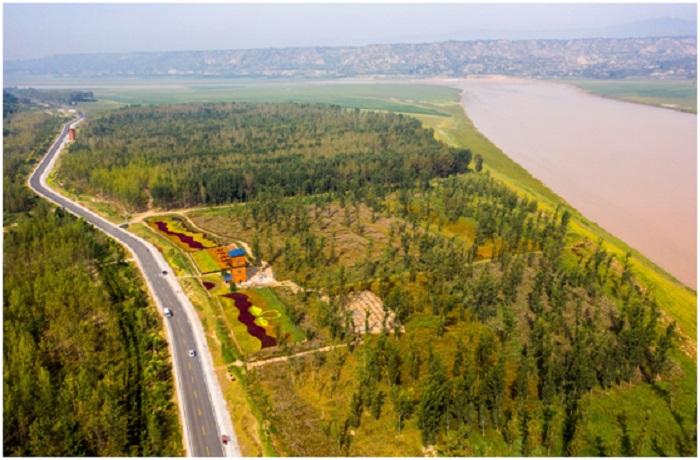



The Yellow River accounts for only 2 percent of China’s water resource, but it is a source of water for 12 percent of the country’s population, 15 percent of its arable land, and over 50 medium- and large-sized cities.
It’s been more than a year since the country convened a symposium on the ecological protection and high-quality development of the Yellow River on Sept. 18, 2019. Over the past year, local governments and departments concerned have largely promoted the economical and intensive use of water resources, so as to advance water conservation in agricultural, industrial and domestic uses. As a result, the Yellow River basin witnessed continuous improvement in water conservation.
China’s Ministry of Water Resources has vigorously promoted water conservation for higher efficiency in the agricultural sector, accelerated the modernization of medium and large irrigation areas, popularized water-saving technologies and optimized crop structure and areas. In 2019, the Yellow River basin’s coefficient of effective use of water in farmland irrigation reached 0.562, and the actual use of irrigation water per mu (667 square meters) stood at 319 cubic meters. Such performance was better than the national average.
In Huaxian county, central China’s Henan province, local agricultural authority has leveled arable land, connected canals and ditches, and implemented the expansion of Yellow River irrigation areas. So far, the county has established high-standard farmland of nearly 1.35 million mu, and another 6 mu will be constructed this year.
According to Bai Xuejie, a major grain grower in Caihu village, Huaxian county, he used to irrigate his land with a diesel engine, but now electrified wells are drilled in the fields, which saves both money and water. In addition, he has learned how to use irrigation sprinklers, which can water 400 mu of land in 3 days and save half of the water volume. Bai told People’s Daily that Huaxian county introduced over 140 million cubic meters of water from the Yellow River last year, and now the county is able to produce 394,400 kilograms more of grains each year while reducing 472,000 cubic meters of irrigation water consumption.
To lower water consumption, strict quotas have been implemented for enterprises, institutions and farmlands, which forced water consumers to determine their demand according to how much quota they get.
Huafang. Co. Ltd. is a textile enterprise in Binzhou, east China’s Shandong province, and its water consumption quota is 3.7 million cubic meters. “It’s not only a red line, but a life line, as half of our production would be halted once the water supply is cut off,” said Yu Tao, deputy chief engineer of the enterprise’s energy system. Every workshop of the company has its respective quota for water consumption, and the actual use of water is recorded in a management platform. “The quota stimulated our enthusiasm to save water, and we have rolled out a series of new techniques and equipment because of it,” Yu said, adding that now waste water of the company is recollected according to their kinds. Last year, the company consumed 0.83 ton of water for every hundred meters of dyed products, which was only half of the amount set in industrial standard, Yu told People’s Daily.
“Over the past year, we have strictly monitored the total water usage and intensity in the Yellow River basin, and implemented rigid water resources argumentation and water abstraction licensing, to ensure that every drop of water was fully exploited,” said Cheng Yanhong, an official with the Ministry of Water Resources.
From July 2019 to June 2020, a total of over 24.29 billion cubic meters of water was abstracted from Yellow River trunk streams in Qinghai, Gansu, Ningxia, Inner Mongolia, Shanxi, Shaanxi, Henan, Shandong and Hebei, 521 million cubic meters less than the annual quota. It is introduced that the water consumption per 10,000 yuan of GDP in the Yellow River basin has been continuously dropping. The figure stood at 55.4 cubic meters last year.
In April this year, the first online water rights trading of the country was completed – Yongning county of Ningxia Hui autonomous region traded the right to use 20 million cubic meters per year for 25 years for 540 million yuan to a local company.
“This mechanism breaks industry restriction with market rules and makes the water flow to where it is needed,” said Chen Dan, an official with Ningxia’s water resource department.
At present, various regions in China are actively exploring the trading mechanisms of water rights and establishing relevant trading platforms. The water exchange is constantly vitalizing the water resources in the Yellow River basin.


The Humanitarian Service Diamond Awards has.
A Chinese Company, Inner Galaxy Steel.


The Programme Coordinator, Regulatory, Compliance and.


A Non-Governmental Organization (NGO), Committee for.
The Trustfund Pensions Limited has chided.


The House of Representatives Committee on.
The China General Chamber of Commerce.


Senator Chuka Utazi who represented Enugu.


An Abuja based Legal Practitioner, Ugochukwu.


The African business community in Yiwu,.
Leave a Comment